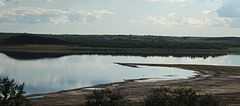Manitou Lake (Saskatchewan)
| Manitou Lake | |
|---|---|
 North-West Bay | |
| Location | Manitou Lake No. 442, Saskatchewan |
| Coordinates | 52°43′N 109°43′W / 52.717°N 109.717°WCoordinates: 52°43′N 109°43′W / 52.717°N 109.717°W |
| Type | Endorheic |
| Primary inflows | None |
| Primary outflows | None |
| Basin countries | Canada |
| Islands | 1 |
| Settlements | Marsden, Neilburg |
Manitou Lake is the largest salt-water lake in the prairie provinces, situated in Western Saskatchewan, near Marsden, and Neilburg, Saskatchewan. Because the lake is endorheic and quite salty, there are no fish in the lake, There is no longer an island in the centre. There is very little development on the lake, although on the North-West Bay there is a park which has a golf course, cabins and a Bible Camp.
The closest towns are Marsden on the northwest corner, and Neilburg on the northeast corner.
Manitou Lake is one of three lakes in the world that share similar chemical composition, the two other lakes are in Israel and the Czech Republic. There are 27 different types of salts dissolved in the water, which is thought to give the water its healing qualities that the ancient Cree claimed.
The lake is fed from Eyehill Creek on the south end, as well as many small springtime meltwater tributaries. The lake overflows to the north into the Battle River, although this has only happened once since European settlers first arrived in the area (approximately 1905). Lake levels were relatively constant until 1980, and have been declining rapidly since then, approximately one meter every six years. Less annual snowfall is blamed for most of this trend, and there is also heavier utilization of the Eyehill Creek system by urban, industrial, and agricultural users on the Saskatchewan side.